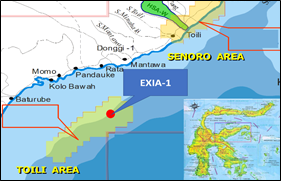Provenance Analysis Based On Petrographic Samples On EXIA-1 Well, Banggai Basin, East Sulawesi, Indonesia
DOI:
https://doi.org/10.25299/jgeet.2024.9.2.13367Keywords:
Provenance, Banggai Basin, Tomori Formation, Tectonic Setting, Petrography, Facies ZoneAbstract
The structure of Exia is composed of Miocene built-up carbonates formed by shear faults. The buildup carbonate feature in the Exia prospect can be seen from the high elevation surrounded by lows with an NNE-SSW and NE-SW trending. The MA-1, SE-1, MI-1 wells are several wells in the Tiaka and Senoro Fields which are proven to have large gas reserves. Tiaka Field is located to the west of the Exia Well, while Senoro Field is to the northeast. The study used primary data from the Exia-1 well in the form of cutting samples. The wet and dry cutting samples were further processed into thin section. This thin section is then carried out for petrographic, XRD, and SEM analysis. Tomori Formation starts from the deeper environment FZ1 upwards to the shallower FZ5 –FZ6 (reef) with open marine and restricted areas. The allochem that composes the limestone at The Matindok Formation consists of red algae fragments and benthic forams which indicate the facies zone of formation in FZ 4 (slope). In the upper Mantawa Formation, it is still quite clear the presence of large forams indicating a reef association environment (FZ5-FZ6), but the presence of a large number of planktonic forams indicates a deeper depositional environment / slope, so it is possible that large forams were transported from a shallower environment. The Kintom Formation have rock provenance ranging from continental blocks in the interior of the craton to a recycled orogeny section of recycled quartz zone.
Downloads
References
Abimanyu, R., 1990. The stratigraphy of the Sulawesi Group in the Tomori PSC, East Arm of Sulawesi, in: Proc. of the 19th IAGI (Indonesian Association of Geologists) Annual Convention and Exhibition. Presented at the 19th IAGI (Indonesian Association of Geologists) Annual Convention and Exhibition, Bandung, pp. 99–118.
Dickinson, W.R. and Suczek, C.A. (1979) Plate Tectonics and Sandstone Compositions. American Association of Petroleum Geologists' Bulletin, 63, 2164-2182.
Garrad, R.A., Supandjono, J.B. and Surono, 1988. The geology of the Banggai-Sula Microcontinent, Eastern Indonesia. Proceedings Indonesian Petroleum Association, 17th Annual Convention, 23-52.
Hasanusi, D., Wijaya, R., Shahab, I. dan Nurhandoko, B.E.B., 2012, Fracture and Carbonate Reservoir Characterization using Sequential Hybrid Seismic Rock Physics, Statistic and Artificial Neural Network: Case Study of North Tiaka Field. Search and Discovery Article #20139 (2012).
Hasanusi, D., Petricola, M., 2006. A surprise discovery using cased hole logs in the Tiaka Field, in: Proc. 2006 Int. Geoscience Conference and Exhibition. Presented at the Jakarta 2006 International Geosciensces Conference & Exhibition, Indonesian Petroleum Association (IPA), Jakarta.
Kurniasih, A., Kusumawijaya, E., Ferdy, Fahrudin, and Setyawan, R., 2021, Biostratigraphy analysis of Barbatos‐1 exploration well in Tomori Block, Banggai Basin, east arm of Sulawesi, Indonesian Journal of Geology and Mining, Vol.31, No 1, pages 51-62
Kurniawan, A.P., Adi, G.P., Arifin, M., Ningrum, A.S., Firman, I., Arifin, A.S., 2017. Pliocene deep water carbonate turbidites play evaluation in the Banggai-Sula Foreland Basin, in: Proc. Indon. Petrol. Assoc., 41st Ann. Conv. Presented at the Forty-First Annual Convention & Exhibition, May 2017, Indonesian Petroleum Association (IPA), Jakarta, p. 14 p.
Nurhidayah, E.M., Akmaludin, Barianto, D.H., Husein, S., Saripudin, S., 2024, Nannoplankton Biostratigraphy from Banggai-Sula Basin, Central Sulawesi, Journal of Tropical Biodiversity and Biotechnology, Yogyakarta, Volume 09, Issue 01
Pigram, C.J. and Surono, 1985. Origin of the Sula Platform, Eastern Indonesia. Geologi 13: 246-248.
Ryacudu, R., Wibowo, T., Handiwiria, Y.E., 1993. Exploration for carbonate reservoir in the Banggai-Sula microcontinent, eastern Indonesia, in: Proc. of the 22nd IAGI (Indonesian Association of Geologists) Annual Convention and Exhibition. Presented at the 22nd IAGI (Indonesian Association of Geologists) Annual Convention and Exhibition, Bandung, pp. 679–692.
Santy L.D., 2016, The Mesozoic Source Rock Identification In Tomori Basin, East Arm Of Sulawesi And Its Implication For Petroleum Play, Proceedings Indonesian Petroleum Association (IPA).
Satyana H.A., Faulin T, Mulyati S. N., 2011, Tectonic Evolution Of Sulawesi Area: Implications For Proven And Prospective Petroleum Plays, The 36th HAGI and 40th IAGI Annual Convention and Exhibition, Makassar.
Sukamto, R., 1975. The structure of Sulawesi in the Light of Plate Tectonics. Paper presented in the Regional Conference of Geology and Mineral Resources, Southeast Asia, Jakarta.
Surono and Sukarna, D., 1995. The Eastern Sulawesi Ophiolite Belt, Eastern Indonesia. A review of it's origin with special reference to the Kendari area. Journal of Geology and Mineral Resources 46: 8-16.
Wilson, M.E.J., 2002. Cenozoic carbonates in Southeast Asia: implications for equatorial carbonate development. Sediment. Geol. 147, 295–428.
Wilson, J.L. 1975. Carbonate Facies In Geologic History. 471 pp., New York: Springer
Yumansa A., Laya K.H., Prataman Y.P., Prasetya A., Kartoatmodjo I.H.B., 2023, Integrated Core Analysis Of Salodik Group: The Pioneering Success For Future Potential Of Collision Margin Carbonate Mega-Sequence In Eastern Indonesia Region, Proceedings of Indonesian Petroleum Association Forty-Seventh Annual Convention & Exhibition.

Downloads
Published
Issue
Section
License
Copyright (c) 2024 Journal of Geoscience, Engineering, Environment, and Technology

This work is licensed under a Creative Commons Attribution-ShareAlike 4.0 International License.
Copyright @2019. This is an open-access article distributed under the terms of the Creative Commons Attribution-ShareAlike 4.0 International License which permits unrestricted use, distribution, and reproduction in any medium. Copyrights of all materials published in JGEET are freely available without charge to users or / institution. Users are allowed to read, download, copy, distribute, search, or link to full-text articles in this journal without asking by giving appropriate credit, provide a link to the license, and indicate if changes were made. All of the remix, transform, or build upon the material must distribute the contributions under the same license as the original.










